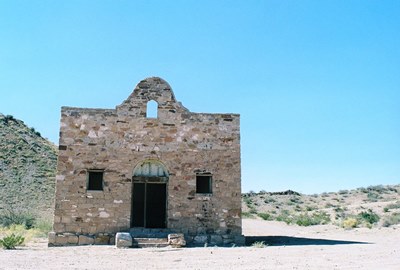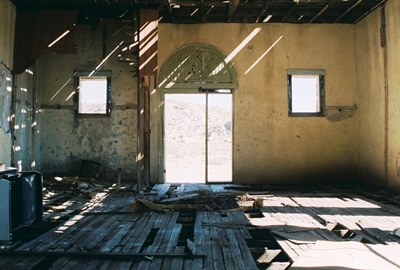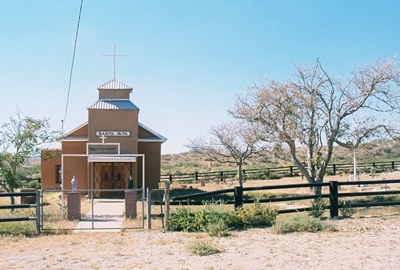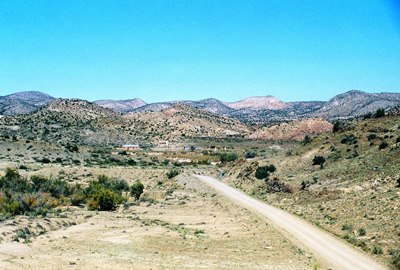
While the Man with No Name might feel right at home in the ghost town of Riley, he and the town might not fully understand each other. That’s because, unlike Sergio Leone’s laconic anti-hero, Riley has two names. Even though the isolated enclave along the oft-dry banks of the Rio Salado was already known as Riley when the post office opened in 1890, many old timers still refer to it by its original name of Santa Rita, bestowed in 1880 when it was a small colony of homesteaded farms established by Mexican-Americans. Riley, it turns out, was the name of a local sheep ranch owner. Maybe there was some sort of naming conflict amongst various livestock factions.

As with any New Mexican ghost town worth its salero, Riley was once a hotbed of mining activity with four active mines pulling coal and manganese out of the dry and dusty earth. By 1897, about 150 people lived in Riley and there were two stores and a stone school (pictured in the two shots above).
While, as has happened to so many ghost towns, the mines eventually did stop paying out, it wasn’t that which ultimately caused Riley’s demise. In fact, the water table dropped due to drought and overgrazing, rendering irrigation tough and farming a losing proposition. Without mining and farming, there wasn’t much else to keep a body busy. In 1931, after 41 years, the post office closed up and that was the end of Riley. Almost.

You see, there is one building that is carefully maintained in Riley: the Santa Rita Church (shown above). Each year on May 22, the Feast Day of Santa Rita, those with ties to the old community come back together and a priest says Mass at the little church. There is a picnic afterward. It must really be something to be a part of. Of course, even at its most bustling the priest only stopped in Riley once every four months.
Riley can be accessed by gravel roads from either the north or south. From the north, you can start at the non-existent town of Bernardo and loop way out around Ladron (i.e, “Thief”) Peak. From the south, you have to drive through the Cibola National Forest and cross the Rio Salado. Either route takes you through a vast and spectacular landscape.

However, while it’s often said that this drive is “easy” by New Mexican off-road standards, both times I’ve been through were touch and go. The first time the Rio Salado was almost uncrossable, not because it was running, but because the north bank had collapsed. This last time would’ve actually been impossible, but following a torrential monsoon the Army Corps of Engineers had just been through and re-graded the whole stretch for us. How nice of them!
I scavenged both Philip Varney and Linda Harris for this one. Varney mentions “five roofless adobes” in his piece on Riley. You’d be hard-pressed to find that many now, but the shot above does show one of the last hold-outs, still sans roof. Below is the view of Riley from the southern approach.

Happy holidays everyone! Next post will be a surprise…to me as much as anyone.
14 comments:
I enjoyed reading about Santa Rita/Riley. Thank you!
I'm glad you liked the post, John. Thanks for stopping by and leaving a comment. JM
My parents were from there, my father grandparents were born there some of my siblings were raised there. We owned my parents property up until 10 or more years ago when a family member sold it, which is pretty sad cause I would kept it to continue our family tradition of a family gathering for the fiesta or just to camp out. I'm the youngest of 11 and I wish I knew more of my parents and grandparents history there.
My Grandparents Lopes and Romero. My dad and mom Manuel Nazaria. Grew up there. They shared many wonderful memories.
The house in the picture was my family’s home. My grandfather built it when he got back from World War I and married my grandmother. My Mom and her sisters were born there. She and I lived there while my Dad was serving in The Korean War. Santa Rita (later Riley) was founded by my great-great-grandfather, Pedro Aragon.
Wow! Thanks for the comment, Julián Gonzales! That's incredible that the adobe in that picture is your family home, and built by your grandfather! One of my favorite things about doing City of Dust is hearing from people that have connections to the places I've written about and photographed and it's been a long time since I've had a surprise like yours! I don't think you can get closer to Santa Rita/Riley than you and your family. Thank you for sharing that history!
You never know what you'll find on the internet, eh?
Best Regards, JM
Do you know if outsiders are welcome to the feast on May 22nd? I was just through Santa Rita today and very intrigued with it's landscape and history.
Hi Unknown,
I'm pretty sure that anyone that makes the effort to get to Santa Rita would be welcome on feast day. However, I'll try to post a request for more information regarding protocol on the City of Dust Facebook page, which you can find HERE. We'll see what we get!
Thanks for your question, and I'm glad you were able to make the trip. It's a spectacular area, isn't it? JM
Unknown, I've got good news! I asked on the City of Dust Facebook page if visitors were welcome on feast day in Santa Rita and got multiple answers in the strongly affirmative.
Here's one:
"My grandparents used to host these festivals here at this church and the one in Kelly. Anyone is welcome to join."
The post itself with additional comments is HERE.
I hope you can make it! Please give us an update if you do! JM
I'm the maternal great grandson of Pedro Aragon who founded Riley New Mexico. He was the dad of my mom's mom.
Looks like we are 2nd or 3rd cousins. My Grandfather was also named Pedro after his grandfather. Your grandmother would be one of his aunts. His aunts were named Petra and Maria.
Julian I’d like to know more. PEDRO is my 4th great grandpa!!
Maria Petra and Francisco Aragon are my grandparents. Josephine Aragon my great grandmother.
Pedro is my descendant grandpa. Pedro>Francisco>Felipe>George>Josephine>Theresa(my grandma). You’d be relayed to my grandma through Aragons
Post a Comment